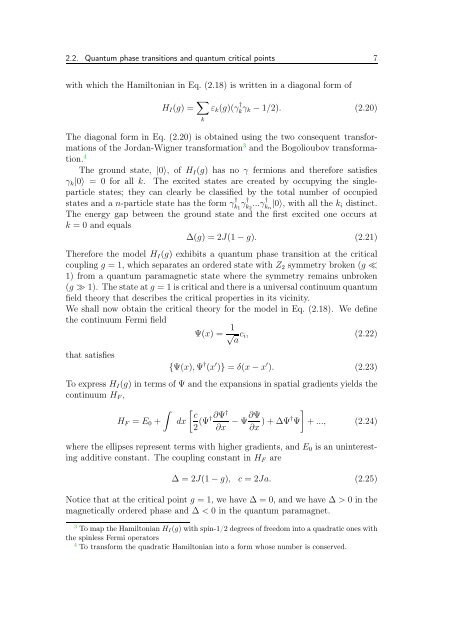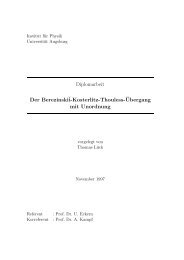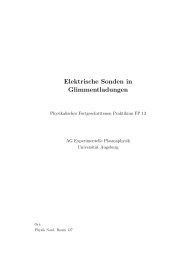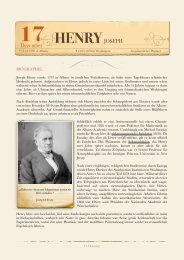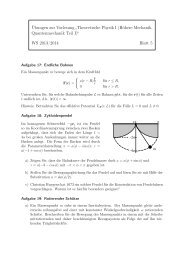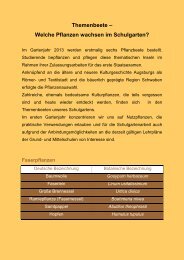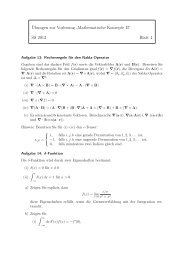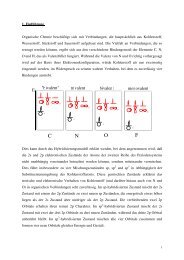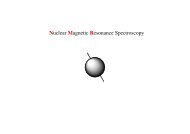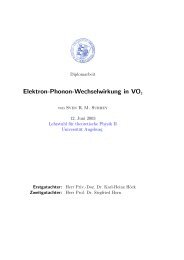Numerical Renormalization Group Calculations for Impurity ...
Numerical Renormalization Group Calculations for Impurity ...
Numerical Renormalization Group Calculations for Impurity ...
Create successful ePaper yourself
Turn your PDF publications into a flip-book with our unique Google optimized e-Paper software.
2.2. Quantum phase transitions and quantum critical points 7<br />
with which the Hamiltonian in Eq. (2.18) is written in a diagonal <strong>for</strong>m of<br />
H I (g) = ∑ k<br />
ε k (g)(γ † k γ k − 1/2). (2.20)<br />
The diagonal <strong>for</strong>m in Eq. (2.20) is obtained using the two consequent trans<strong>for</strong>mations<br />
of the Jordan-Wigner trans<strong>for</strong>mation 3 and the Bogolioubov trans<strong>for</strong>mation.<br />
4<br />
The ground state, |0〉, of H I (g) has no γ fermions and there<strong>for</strong>e satisfies<br />
γ k |0〉 = 0 <strong>for</strong> all k. The excited states are created by occupying the singleparticle<br />
states; they can clearly be classified by the total number of occupied<br />
states and a n-particle state has the <strong>for</strong>m γ † k 1<br />
γ † k 2<br />
...γ † k n<br />
|0〉, with all the k i distinct.<br />
The energy gap between the ground state and the first excited one occurs at<br />
k = 0 and equals<br />
∆(g) = 2J(1 − g). (2.21)<br />
There<strong>for</strong>e the model H I (g) exhibits a quantum phase transition at the critical<br />
coupling g = 1, which separates an ordered state with Z 2 symmetry broken (g ≪<br />
1) from a quantum paramagnetic state where the symmetry remains unbroken<br />
(g ≫ 1). The state at g = 1 is critical and there is a universal continuum quantum<br />
field theory that describes the critical properties in its vicinity.<br />
We shall now obtain the critical theory <strong>for</strong> the model in Eq. (2.18). We define<br />
the continuum Fermi field<br />
Ψ(x) = 1 √ a<br />
c i , (2.22)<br />
that satisfies<br />
{Ψ(x), Ψ † (x ′ )} = δ(x − x ′ ). (2.23)<br />
To express H I (g) in terms of Ψ and the expansions in spatial gradients yields the<br />
continuum H F ,<br />
∫<br />
H F = E 0 +<br />
[ ]<br />
c<br />
dx<br />
2 (Ψ†∂Ψ† ∂x − Ψ∂Ψ ∂x ) + ∆Ψ† Ψ + ..., (2.24)<br />
where the ellipses represent terms with higher gradients, and E 0 is an uninteresting<br />
additive constant. The coupling constant in H F are<br />
∆ = 2J(1 − g), c = 2Ja. (2.25)<br />
Notice that at the critical point g = 1, we have ∆ = 0, and we have ∆ > 0 in the<br />
magnetically ordered phase and ∆ < 0 in the quantum paramagnet.<br />
3 To map the Hamiltonian H I (g) with spin-1/2 degrees of freedom into a quadratic ones with<br />
the spinless Fermi operators<br />
4 To trans<strong>for</strong>m the quadratic Hamiltonian into a <strong>for</strong>m whose number is conserved.


